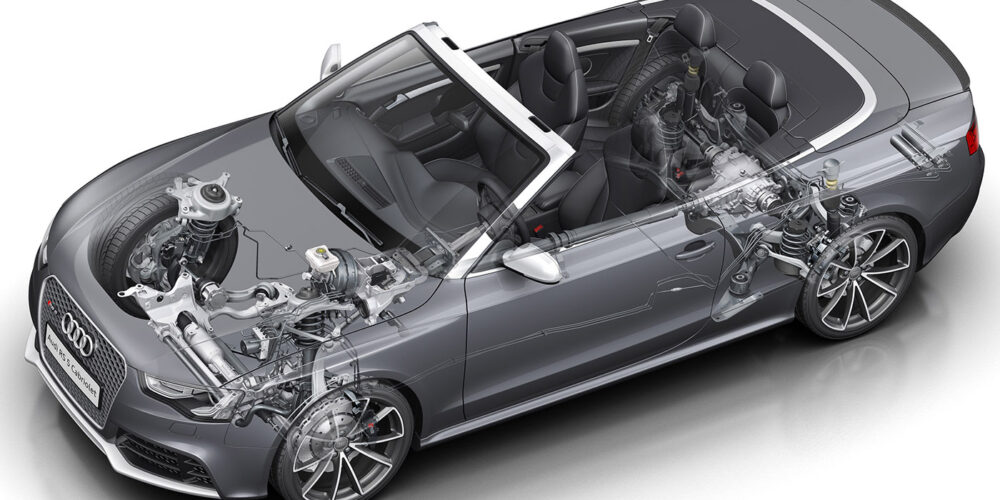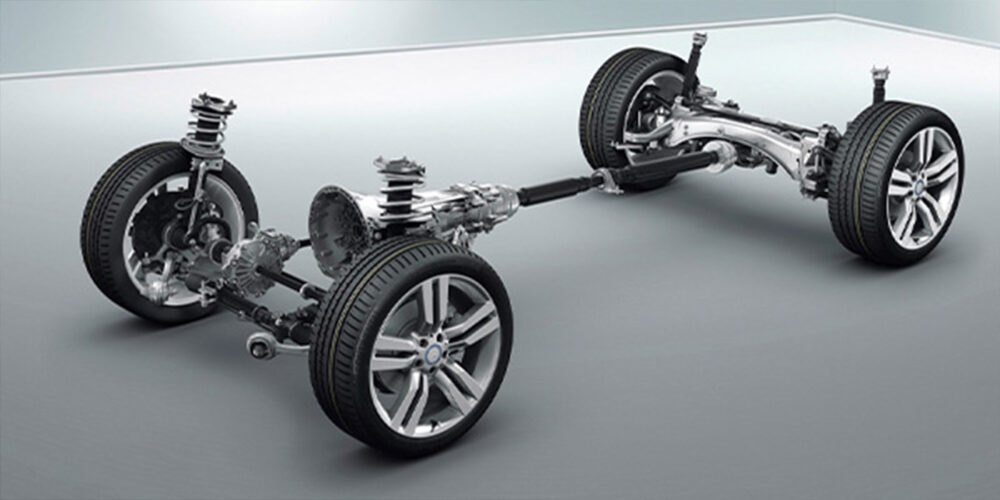In 2012, Audi, VW and Porsche started reducing their platforms like many other manufacturers. For larger vehicles with longitudinally mounted engines, Audi named the platform Modularer Längs Baukasten or MLB. The origins of the platform date back to the 2006 A5.
In the past decade, MLB has been used for everything from the A4 to the A8. It has even been used for the Porsche Macan. The alignment of these vehicles can be straightforward mechanically. But, as the models get more luxurious, features like air suspension and adaptive cruise control can make the alignment more complex.
Adaptive Air Suspension and Struts
The air ride system on most Audi MLB vehicles is not a stand-alone system. Instead, it relies on four modules to quickly adjust the vehicle’s ride height and dampener settings. The level system control module mounted in the trunk connects to the Sensor Electronic Control Module using a FlexRay data bus. This control module is located near the center of gravity under the center console. It measures acceleration and movement of the car along the X, Y and Z axis, other information from the ABS hydraulic control unit and the ride height sensors at all four wheels.
When aligning an MLB Audi like the A7 or A8, engage the comfort or basic settings for the suspension. Do not use the “lift” or “dynamic” modes. You can engage a service or jack mode on some models using the infotainment system. Some models recognize when the vehicle is being raised on a hoist or at the wheel and prevents all control procedures. Air is released for a short time before automatic detection. For safety reasons, it is recommended to always switch the control system off and select the “jack mode.” Jack mode deactivates when the vehicle exceeds 6 mph.
Steering
Some MLB Audi models use recirculating ball electric power steering which uses an electric motor that acts on a ball screw assembly. The steering rack passes through the center of the electric motor. Chances are you will never see the internals because the core charge for a rack can be pricey. The thing to remember is the ball screw assembly is very precise. Any noise, excess friction or play needs additional inspection.
The steering system has a torque sensor located on the shaft near the rack. The steering angle sensors are located in the steering column. The sensors must be recalibrated or adapted after an alignment or steering component replacement. The procedure will require a scan tool so it can learn the steering end stops.
If the steering angle sensor or the torque sensor are not calibrated, it might turn on the yellow light in the shape of a steering wheel on the instrument cluster. Also, power assist will be limited to 60%. Setting the stops will turn out the light.
If the steering wheel light is red, it indicates active codes, and the assist is set to only 20%. Further diagnostics are required.
Front Suspension
The front suspension uses a five-link design. The tall knuckle uses two links at the top and two at the bottom. And, if you count the steering tie rod, you get five links. The design allows the suspension to optimize the scrub radius and other alignment angles. The good news for shops is there are eight ball joints that can wear out.
The front camber is not factory adjustable. Audi recommends “camber balancing” if the specifications are out of alignment. You can purchase adjustable upper links that provide ±1.5º of camber and caster. If the camber is out more than 1.5º, check the condition of the bushings on all four arms and look at the cross camber to determine if the cradle has shifted.
Rear Suspension
The MLB platform uses Audi’s “trapezoidal link” suspension in the rear. The toe can be adjusted using the lower control arm’s inboard forward bushing using an eccentric. Camber can be adjusted using the eccentric bolt on the outboard upper control link.
It is common for the lower control arm bushings to wear and cause negative toe and camber. Always inspect the bushings before trying to set the rear toe.
Before you even attempt to perform an ADAS calibration on an Audi, you need to prepare the vehicle. Always make sure the vehicle has a full tank of fuel. The next step is to make sure all the tires are the same and properly inflated. If the tires have different rolling diameters, it can change the body’s height and the aim of the ADAS sensors.
An alignment should also be performed to make sure the thrust line is within specifications. As part of the alignment, the steering angle sensor should also be reset. Failing to reset the sensor might cause a steering pull and issues with the electric power steering system.
If the Audi car or SUV you are calibrating has an air suspension, the control position must be calibrated. This will set the correct body height for the ADAS calibration. You want to perform this step before the alignment. The procedure is performed with a scan tool and measurement tool.
If static ADAS calibrations scare you, take a step back to understand what is going on. Static calibration involves placing a target at a known distance in relation to the vehicle’s sensors. If a camera is being calibrated, the target will have a pattern that matches the factory configuration. For radar sensors, the unit will emit radiowaves and bounce them off the target. The accuracy of the calibration depends on the placement of the targets.
Some ADAS calibration systems use the Audi ring emblem on the front and rear of the vehicle to find the centerline. Other systems might use targets on the rear wheel to find the centerline, and distance and centering for the target fixture. Some ADAS tools use tape measures, while other systems use lasers. The critical thing to remember is to follow the instructions.















